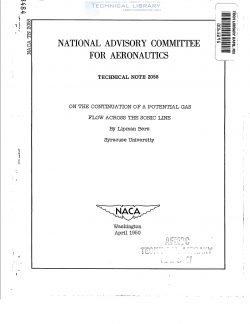naca-tn-2058
- Version
- 47 Downloads
- 1.82 MB File Size
- 1 File Count
- December 9, 2016 Create Date
- December 9, 2016 Last Updated
National Advisory Committee for Aeronautics, Technical Notes - On the Continuation of a Potential Gas Flow Across the Sonic Line

Simple, sufficient conditions are given under which a two—dimensional
steady compressible flow can be continued across the line of Mach number 1
as a continuous supersonic flow. Methods for the actual computation of
the flow are described. The problem is of importance in the theory of
transonic flows past airfoils.
The theory of mixed subsonic and stmersonic flows of a compressible
fluid is as yet very incomplete. As a contribution to such a theory,
the problem of continuing a two—dimensional subsonic gas flow across a
line along which the speed of the flow reaches that of sound is consid-
ered in this paper. Rather simple, sufficient conditions under which
the continuation is possible and is uniquely determined are given
(section 1) . The problem is of interest in connection with transonic
flows past obstacles (see section 7).
The mathematical nucleus of the problem is the solution of a Cauchy
problem fora partial differential equation of mixed elliptico—hmerbolic
type. This problem is solved in the appendix by a method which is
believed to be intrinsically simpler than the previous treatment by
Christianovitch in a paper unavailable in this country1 and by Frankl
(reference 1) . The theoretical discussion contained in the appendix
(sections 5 and 6) yields methods for the actual computation of the flow
in the supersonic region.
This investigation was carried out at Syracuse University under the
sponsorship and with the financial assistance of the National Advisory
Committee for Aeronautics.
| File | Action |
|---|---|
| naca-tn-2058 On the Continuation of a Potential Gas Flow Across the Sonic Line.pdf | Download |

Comment On This Post